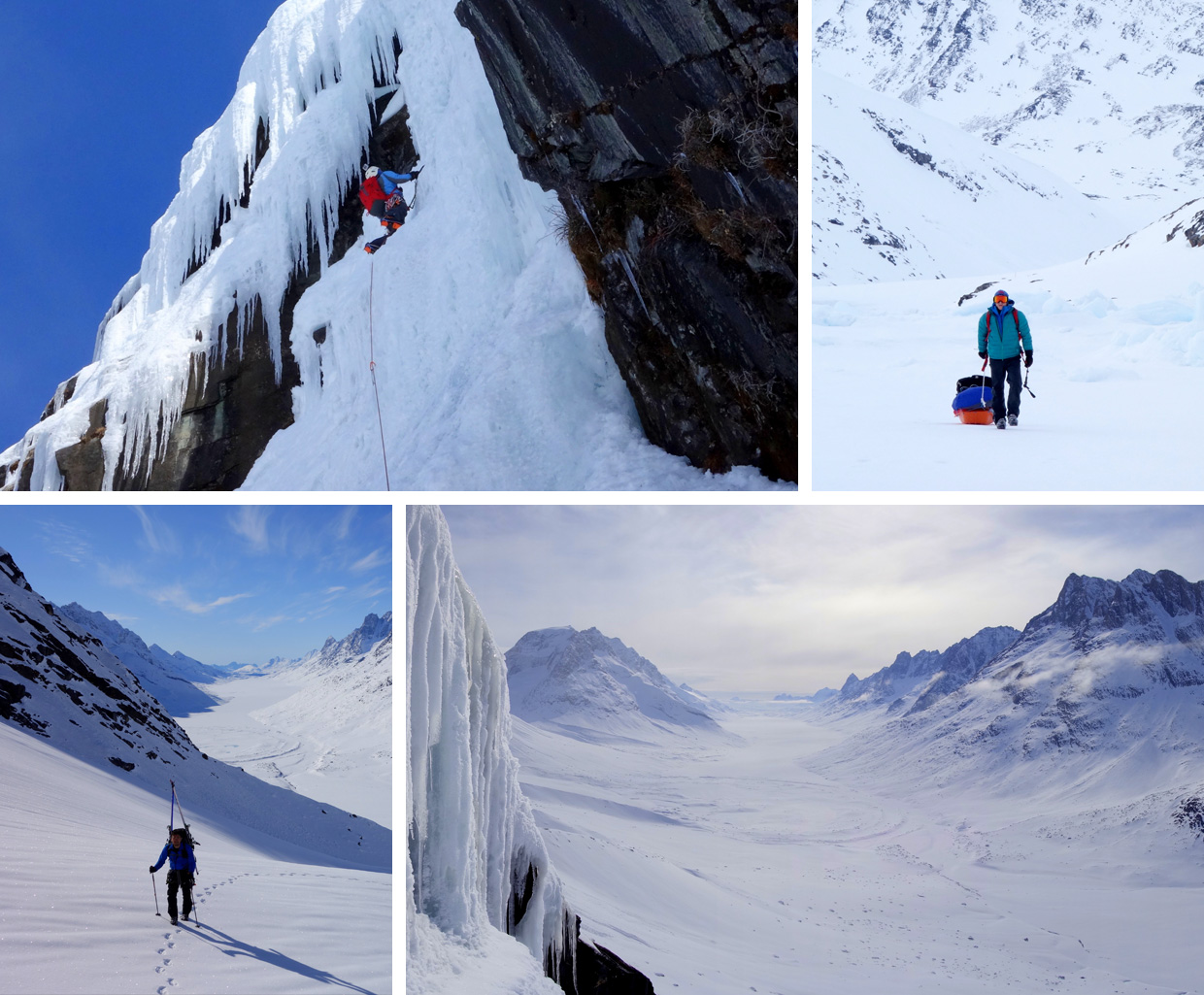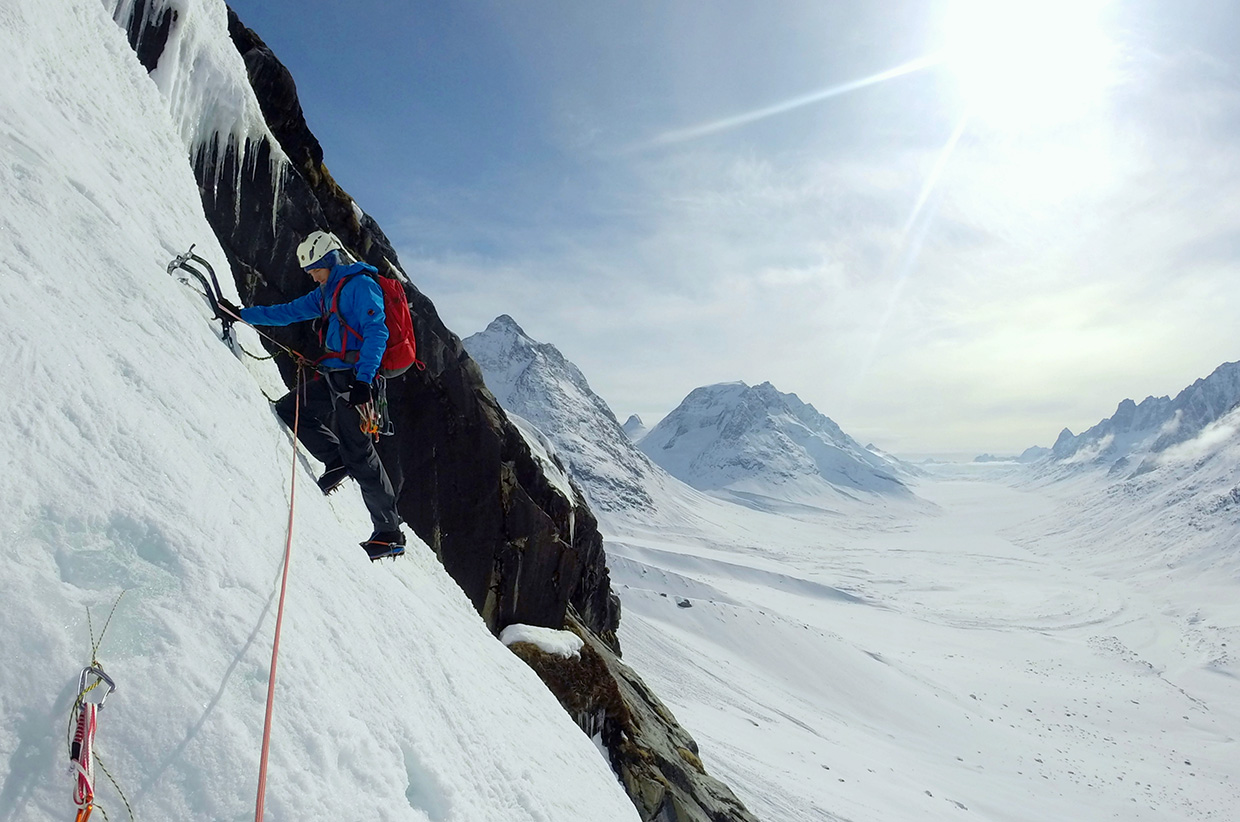A Breath of Arctic Air
Finn McCann
I let out a long, calming sigh and looked across to my brother Niall; he gave me a nod which I returned in kind before turning to face down the mountain. It was time to commit. We stood poised, hearts thumping, eyes fixed on the edge we were about to ski off. Behind each of us lay our wings. Tiny canopies known as ‘Speedwings’. Our lifelines. Without them, what we were about to do would be suicide.
Six months ago I’d never heard of Speedwings, I was totally obsessed with climbing and had no time for any other disciplines. My life revolved around continually preparing for the next climbing mission: training, researching, training, researching. But then, abruptly, a unexpected spanner was tossed into the works: training, researching, training, injured. I had over-trained and paid the price, sustaining serious tendon damage to my right hand. I knew instantly it was going to take more than just a few months to recover. Initially I panicked, wondering what I would do without climbing in my life. That concern quickly evolved into something different: “what can I do now that I’m not climbing?” It was a subtle, but significant, change of mentality. Rather than feeling lost, I actually felt liberated. I could do anything I wanted! I flirted with different ideas. Surfing, kayaking, slacklining. But my mind kept drifting back to the mountains. I need to be in the mountains. And then it came to me: I’d train in a sport that could be combined with mountaineering, a sport that would complement it, or even enhance it. The main drawback of climbing is that you spend all your time fighting gravity and never truly exploiting all the hard earned elevation that you’ve gained. I was going to remedy that, and the answer was Speedflying. I had absolutely no experience whatsoever in any aviation sports, but that didn’t matter. I had a vision and I was going to make it happen. “… eight… seven… six…” After convincing my brother Niall to take up the sport too, we set about planning an expedition in which we would combine Alpinism and Speedflying. Alpine climbing, using crampons and ice axes, wouldn’t be hampered by my injury and would allow us to launch our Speedwings on skis; a safer and more practical option than foot launching. The Speedwings themselves weigh only 2.5kgs so could be stuffed into the bottom of our sacks without encumbering us whilst climbing. Our criteria for the trip was that we wanted to travel to somewhere truly remote. Somewhere that would require an exciting and adventurous approach; somewhere where it wasn’t possible to purchase a destination guide before heading off. After weeks of researching we found our perfect destination in the form of a secluded valley in the Eastern mountain range of Greenland. Detailed maps don’t exist of the area, but satellite imagery showed steep-sided peaks rising thousands of feet above sweeping white and blue glaciers. Perfect! Now we just had to figure out how to get there.
The main drawback of climbing is that you spend all your time fighting gravity and never truly exploiting all the hard earned elevation that you’ve gained. I was going to remedy that, and the answer was Speedflying.

This was the end of the line for the boat, we offloaded our skis and sledges and waved goodbye to our boatman as he motored out of sight. From here on in we were totally on our own. And we felt it.
The following morning’s departure was delayed because a large quantity of sea ice had blown into the bay overnight meaning that we couldn’t get out by boat. Not a problem. Just a few hours later we set off along the coast on a snowmobile, driving for an hour with sledges in tow, until we arrived at an area of consolidated sea ice where we waved goodbye to our friend from Kulusuk and trudged across the ice to meet a boatman from a neighbouring village. For the next few hours we quietly motored through a labyrinth of steep-sided, mountainous islands. The outboards gentle “put-put” was the only noise in an otherwise silent landscape. I snapped out of my day-dream when the boatman put in a few extra revs to launch us onto the ice at the cusp of a frozen fjord. This was the end of the line for the boat, we offloaded our skis and sledges and waved goodbye to our boatman as he motored out of sight. From here on in we were totally on our own. And we felt it.
“… five… four… three…”
We set up our basecamp half a day’s ski up the fjord. It was beyond exciting to be sat in a range of mountains, not dissimilar to the Mont Blanc massif in character, and yet have the place totally to ourselves. Where to start? There were so many possible objectives. The following day we had our first training flight. Having skied up the side of a dramatic blue-green glacier we created launch pads on a gently-angled slope perched a few hundred metres above the top of the glacier. Setting off one behind the other we enjoyed a blissful descent; effortlessly swooping low over the tumultuous seracs and crevasses before touching down and skiing for a further minute, coming to a stop just a few hundred metres from our camp.


We returned to camp that evening knowing that we were ready. Looking out from our tent we picked out a particularly exciting looking mountain with a dramatic glacier tumbling down from just below the summit. This was our mountain. This was what we’d come out to do.
So that’s how we found ourselves here. Perched on the very summit of an unnamed peak with the most beautiful mountain range spread out beneath us, not another soul for miles, seconds away from launching into the unknown. I inhale a deep breath of cold Arctic air.
“… two… one… Go!”
Perched on the very summit of an unnamed peak with the most beautiful mountain range spread out beneath us, not another soul for miles, seconds away from launching into the unknown. I inhale a deep breath of cold Arctic air.
Arctic Air is screening at the Kendal Mountain Festival as part of the mountaineering programme shown at various times during the weekend. For more information visit: mountainfest.co.uk.
Finn McCann is a 27 year-old climber and adventurer on the Mammut UK team. Over the last twelve years Finn has been on more than twenty-five overseas expeditions with ascents of high altitude mountains in the Himalayas, multi-day big walls and technical Alpine mixed routes. Outside of climbing he has cycled the highest road in the world, sailed to the Antarctic, skied across Greenland and slacklined 3000ft above the deck. Along with his brother, Finn runs a social enterprise organisation called Talk on the Wild Side, aiming to inspire young people to challenge themselves and have adventures.
Website: www.finnmccannadventures.com
Website: www.niallmccann.com
Twitter: @NiallPMcCann




